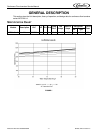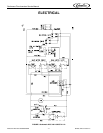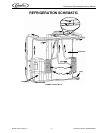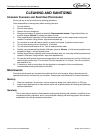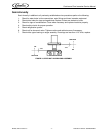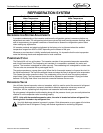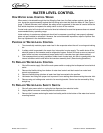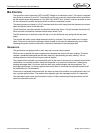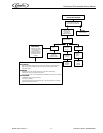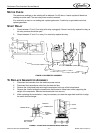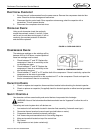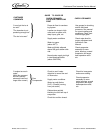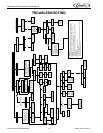
Continuous Flow Icemaker Service Manual
Publication Number: 630460324SER - 10 - © 2006, IMI Cornelius Inc.
BIN CONTROL
The type of bin control used on all WCC and WCF Models is an electronic control. The control is supplied
with power to terminals X1 and X2. Terminals X3 and X4 are a normally closed switch which open when
the thermostat sensor bulb senses ice. The WCC1401-A/WCF1401-A uses 2 controls, terminals X1 and
X2 are connected in parallel and terminals X3 and X4 are connected in series.
The sensing bulbs are located in a 5/16” stainless steel tube which hangs from the dispense tray covers
down through the center of the drop tube.
To test the switch, start the icemaker and block the outlet tube, about ½ full the icemaker should shut off.
When the tube is cleared the icemaker should restart within 5 min.
The Bin controls are in electrical series with the coil on the antifreeze relay along with the low water
safety.
The controls are held in place inside the electrical box by 4 screws. The control bulbs are in the drop
tubes. They can be removed by pulling the cable located on the top of the dispense tray cover. When
replacing the sensor make sure the bulb is inserted to the bottom of the thermostat well.
GEARMOTOR
The gearmotors are equipped with a start relay and a manual reset overload.
When current is applied, the relay energizes and completes the circuit to the start winding. The motor
reaches a predetermined speed and the relay drops out, disconnecting the start winding. The run
winding remains in the circuit as long as current is applied.
The purpose of the overload is to automatically shut off the motor in the event of a mechanical bind of the
transmission, an overload condition within the evaporator or an electrical malfunction. It does this by
sensing amperage draw. If the motor stalls the start relay would energize and stay energized. The
amperage would surge 5 to 6 times greater than normal draw. In this event the overload would shut off
the transmission in 4 to 8 seconds.
If the motor is subjected to abnormal load, but does not reach stall condition, the overload will react, but
over a greater period of time. The reaction time depends upon the amperage to which it is subjected.
The overloads to each motor are connected in series; if either overload trips both gearmotors and the
liquid line solenoid are shut off.



